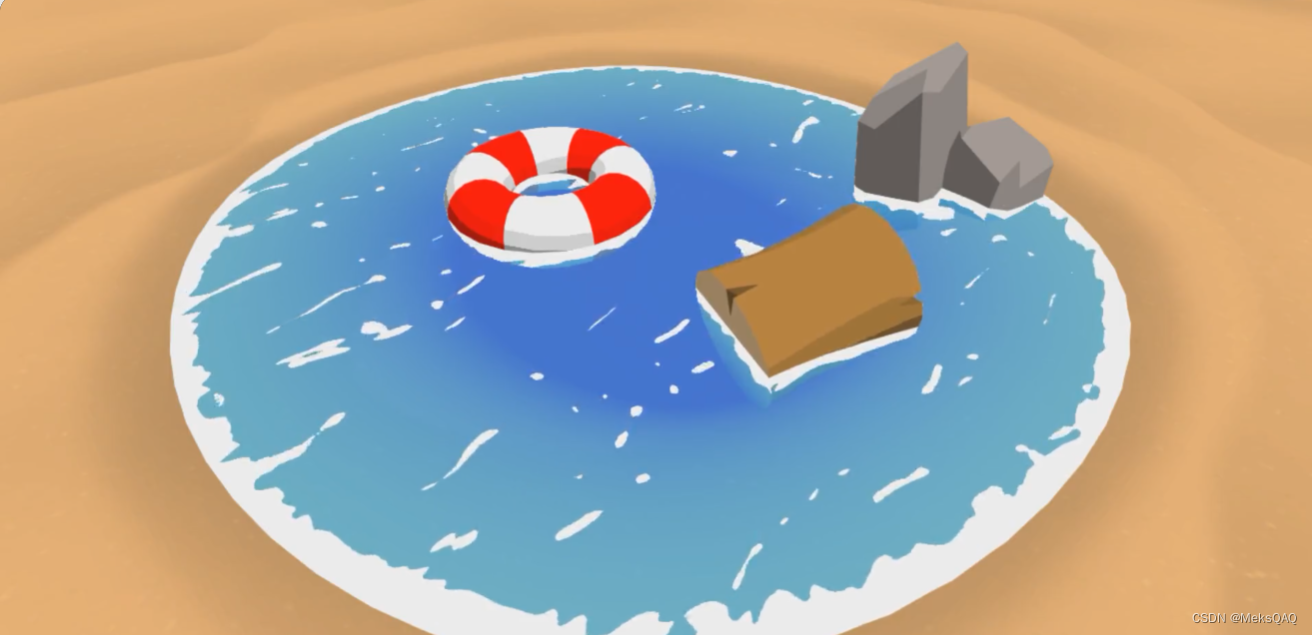
案例中水体设置成ZWrite Off,不写入深度,通过unity相机的深度图计算出水底的深度,再通过齐次坐标的w分量获得水面的深度。两者相减获得水体的深度,设置一个最大深度,根据水体深度插值控制水体颜色渐变。
泡沫效果是直接采用噪音贴图采样,然后设置阙值,对噪音贴图进行二进制效果转换让噪音贴图变得干净,然后根据深度截止边缘处的阙值。
对对噪音贴图进行采样的uv增加随时间流动,实现水体的流动。
增加扭曲纹理,采样后与噪音贴图的uv相加,实现更多复杂的流动。
通过获取unity相机中深度法线图,获取水底和水中物体的法线,再获取水面的视空间法线,两者点积,当点积较大时(没有物体)使用较大的泡沫阙值;当点积较小时(物体表面的法线和水体表面的法线接近垂直)使用小的泡沫阙值。根据上述原理对阙值进行插值再导入函数中。
锯齿问题:因为泡沫alpha值是极端的要么0要么1,所以设置smoothStep函数将alpha从0平滑混合到1
#define SMOOTHSTEP_AA 0.01
…
float surfaceNoise = smoothstep(surfaceNoiseCutoff - SMOOTHSTEP_AA, surfaceNoiseCutoff + SMOOTHSTEP_AA, surfaceNoiseSample);o.screenPosition = ComputeScreenPos(o.vertex);float existingDepth01 = tex2Dproj(_CameraDepthTexture,UNITY_PROJ_COORD(i.screenPosition)).r;
float existingDepthLinear = LinearEyeDepth(existingDepth01);
float depthDifference = existingDepthLinear - i.screenPosition.w;案例原网址:
wUnity Toon Water Shader Tutorial![]() https://roystan.net/articles/toon-water/江陵野少这里对齐次坐标的概念和为什么用齐次坐标的w分量作为顶点的深度进行了解释。
https://roystan.net/articles/toon-water/江陵野少这里对齐次坐标的概念和为什么用齐次坐标的w分量作为顶点的深度进行了解释。
ComputeScreenPos(a)是将顶点转换成屏幕坐标值,但是是一个齐次空间坐标。顶点变换到齐次裁剪坐标,为裁剪做准备,并未进行透视除法。所以顶点齐次坐标w值为-z。
Unity Shader ScreenPos详解 - 知乎 (zhihu.com)![]() https://zhuanlan.zhihu.com/p/258036220
https://zhuanlan.zhihu.com/p/258036220
源码:
Shader "Roystan/Toon/Water Tut"
{
Properties
{
// What color the water will sample when the surface below is shallow.
_DepthGradientShallow("Depth Gradient Shallow", Color) = (0.325, 0.807, 0.971, 0.725)
// What color the water will sample when the surface below is at its deepest.
_DepthGradientDeep("Depth Gradient Deep", Color) = (0.086, 0.407, 1, 0.749)
// Maximum distance the surface below the water will affect the color gradient.
_DepthMaxDistance("Depth Maximum Distance", Float) = 1
// Color to render the foam generated by objects intersecting the surface.
_FoamColor("Foam Color", Color) = (1,1,1,1)
// Noise texture used to generate waves.
_SurfaceNoise("Surface Noise", 2D) = "white" {}
// Speed, in UVs per second the noise will scroll. Only the xy components are used.
_SurfaceNoiseScroll("Surface Noise Scroll Amount", Vector) = (0.03, 0.03, 0, 0)
// Values in the noise texture above this cutoff are rendered on the surface.
_SurfaceNoiseCutoff("Surface Noise Cutoff", Range(0, 1)) = 0.777
// Red and green channels of this texture are used to offset the
// noise texture to create distortion in the waves.
_SurfaceDistortion("Surface Distortion", 2D) = "white" {}
// Multiplies the distortion by this value.
_SurfaceDistortionAmount("Surface Distortion Amount", Range(0, 1)) = 0.27
// Control the distance that surfaces below the water will contribute
// to foam being rendered.
_FoamMaxDistance("Foam Maximum Distance", Float) = 0.4
_FoamMinDistance("Foam Minimum Distance", Float) = 0.04
}
SubShader
{
Tags
{
"Queue" = "Transparent"
}
Pass
{
// Transparent "normal" blending.
Blend SrcAlpha OneMinusSrcAlpha
ZWrite Off
CGPROGRAM
#define SMOOTHSTEP_AA 0.01
#pragma vertex vert
#pragma fragment frag
#include "UnityCG.cginc"
// Blends two colors using the same algorithm that our shader is using
// to blend with the screen. This is usually called "normal blending",
// and is similar to how software like Photoshop blends two layers.
float4 alphaBlend(float4 top, float4 bottom)
{
float3 color = (top.rgb * top.a) + (bottom.rgb * (1 - top.a));
float alpha = top.a + bottom.a * (1 - top.a);
return float4(color, alpha);
}
struct appdata
{
float4 vertex : POSITION;
float4 uv : TEXCOORD0;
float3 normal : NORMAL;
};
struct v2f
{
float4 vertex : SV_POSITION;
float2 noiseUV : TEXCOORD0;
float2 distortUV : TEXCOORD1;
float4 screenPosition : TEXCOORD2;
float3 viewNormal : NORMAL;
};
sampler2D _SurfaceNoise;
float4 _SurfaceNoise_ST;
sampler2D _SurfaceDistortion;
float4 _SurfaceDistortion_ST;
v2f vert (appdata v)
{
v2f o;
o.vertex = UnityObjectToClipPos(v.vertex);
o.screenPosition = ComputeScreenPos(o.vertex);
o.distortUV = TRANSFORM_TEX(v.uv, _SurfaceDistortion);
o.noiseUV = TRANSFORM_TEX(v.uv, _SurfaceNoise);
o.viewNormal = COMPUTE_VIEW_NORMAL;
return o;
}
float4 _DepthGradientShallow;
float4 _DepthGradientDeep;
float4 _FoamColor;
float _DepthMaxDistance;
float _FoamMaxDistance;
float _FoamMinDistance;
float _SurfaceNoiseCutoff;
float _SurfaceDistortionAmount;
float2 _SurfaceNoiseScroll;
sampler2D _CameraDepthTexture;
sampler2D _CameraNormalsTexture;
float4 frag (v2f i) : SV_Target
{
// Retrieve the current depth value of the surface behind the
// pixel we are currently rendering.
float existingDepth01 = tex2Dproj(_CameraDepthTexture, UNITY_PROJ_COORD(i.screenPosition)).r;
// Convert the depth from non-linear 0...1 range to linear
// depth, in Unity units.
float existingDepthLinear = LinearEyeDepth(existingDepth01);
// Difference, in Unity units, between the water's surface and the object behind it.
float depthDifference = existingDepthLinear - i.screenPosition.w;
// Calculate the color of the water based on the depth using our two gradient colors.
float waterDepthDifference01 = saturate(depthDifference / _DepthMaxDistance);
float4 waterColor = lerp(_DepthGradientShallow, _DepthGradientDeep, waterDepthDifference01);
// Retrieve the view-space normal of the surface behind the
// pixel we are currently rendering.
float3 existingNormal = tex2Dproj(_CameraNormalsTexture, UNITY_PROJ_COORD(i.screenPosition));
// Modulate the amount of foam we display based on the difference
// between the normals of our water surface and the object behind it.
// Larger differences allow for extra foam to attempt to keep the overall
// amount consistent.
float3 normalDot = saturate(dot(existingNormal, i.viewNormal));
float foamDistance = lerp(_FoamMaxDistance, _FoamMinDistance, normalDot);
float foamDepthDifference01 = saturate(depthDifference / foamDistance);
float surfaceNoiseCutoff = foamDepthDifference01 * _SurfaceNoiseCutoff;
float2 distortSample = (tex2D(_SurfaceDistortion, i.distortUV).xy * 2 - 1) * _SurfaceDistortionAmount;
// Distort the noise UV based off the RG channels (using xy here) of the distortion texture.
// Also offset it by time, scaled by the scroll speed.
float2 noiseUV = float2((i.noiseUV.x + _Time.y * _SurfaceNoiseScroll.x) + distortSample.x,
(i.noiseUV.y + _Time.y * _SurfaceNoiseScroll.y) + distortSample.y);
float surfaceNoiseSample = tex2D(_SurfaceNoise, noiseUV).r;
// Use smoothstep to ensure we get some anti-aliasing in the transition from foam to surface.
// Uncomment the line below to see how it looks without AA.
// float surfaceNoise = surfaceNoiseSample > surfaceNoiseCutoff ? 1 : 0;
float surfaceNoise = smoothstep(surfaceNoiseCutoff - SMOOTHSTEP_AA, surfaceNoiseCutoff + SMOOTHSTEP_AA, surfaceNoiseSample);
float4 surfaceNoiseColor = _FoamColor;
surfaceNoiseColor.a *= surfaceNoise;
// Use normal alpha blending to combine the foam with the surface.
return alphaBlend(surfaceNoiseColor, waterColor);
}
ENDCG
}
}
}





















 1789
1789











 被折叠的 条评论
为什么被折叠?
被折叠的 条评论
为什么被折叠?








